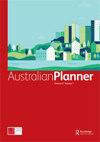Working with reverberations: new ways for small towns
IF 1.2
Q2 Social Sciences
引用次数: 3
Abstract
ABSTRACT Typically, metropolitan governance literature and practice has lacked focus on the ways that processes of urbanisation affect rural areas or small towns. As urbanisation is increasingly recognised as a process that reverberates across peri-urban and rural regions, the entwined and interdependent nature of governance across scales becomes evident. This interaction is recognised in the 2017 iteration of Plan Melbourne’s directions relating to peri-urban and regional areas. This illustrates the need for planning to respond to opportunities and challenges arising from interactions between small towns and metropolitan governance. This article investigates these gaps in two ways: Firstly, by introducing the idea of reverberations to describe the effects of external factors like metropolitan governance exert on lived experience in small towns. Secondly, we use reflective practice to explore how working with those reverberations has shaped the development of a place-based ecological model for small-town planning. Informed by the work of practitioners and scholars such as Randolph Hester, David Seamon and Patsy Healey, the place-based ecological model innovates by bringing a phenomenological and relational sensibility to planning, fostering place-based assets to allow for responses to reverberations, and address existing gaps in planning practice. The article then suggests future directions for the evolution of small-town planning and governance frameworks.利用混响:小城镇的新方法
通常,城市治理文献和实践缺乏对城市化进程影响农村地区或小城镇的方式的关注。随着人们越来越认识到城市化是一个在城市周边和农村地区产生影响的过程,跨尺度治理的相互交织和相互依存的性质变得明显。这种相互作用在2017年墨尔本规划与城郊和区域有关的方向中得到了认可。这说明需要进行规划,以应对小城镇与都市治理之间相互作用所产生的机遇和挑战。本文从两个方面探讨了这些差异:首先,通过引入回响的概念来描述城市治理等外部因素对小城镇生活体验的影响。其次,我们使用反思性实践来探索如何利用这些回响来塑造基于地点的小城镇规划生态模型的发展。根据Randolph Hester, David Seamon和Patsy Healey等实践者和学者的工作,基于地的生态模型通过将现象学和关系敏感性引入规划,培育基于地的资产以允许对反响做出反应,并解决规划实践中的现有差距来进行创新。然后,文章提出了小城镇规划和治理框架演变的未来方向。
本文章由计算机程序翻译,如有差异,请以英文原文为准。
求助全文
约1分钟内获得全文
求助全文

 求助内容:
求助内容: 应助结果提醒方式:
应助结果提醒方式:


